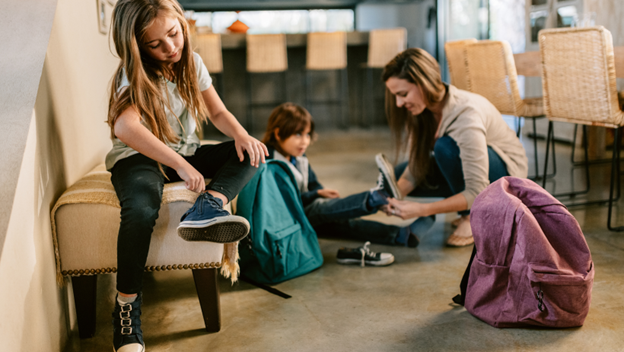Ease Into the Back-to-School Routine by following these strategies as summer winds down. The first day of school is approaching and transitioning back to a structured routine can be challenging for both children and parents. However, with some planning and preparation, you can make the shift smoother and less stressful.
Easing into the back-to-school routine doesn’t have to be daunting; it’s all about gradually introducing structure, setting clear expectations, and fostering an environment that encourages learning and growth. Let’s explore some strategies to help you and your child confidently navigate this transition.
Create a Bedtime Routine
Bedtime routines are crucial for children as they promote better sleep quality. Consisting of repetitive activities like brushing teeth, wearing pajamas, and story reading, these routines help children relax, providing a sense of security. They also teach self-reliance in falling asleep. Research indicates that consistent bedtime practices result in earlier sleep times, quicker sleep onset, longer sleep duration, and fewer night awakenings. The positive effects extend beyond the immediate term, contributing to healthier sleep patterns in later years. Dimming lights and limiting screen time can further enhance this routine’s effectiveness. (Correll)
Do’s for a Better Bedtime Routine:
Establish Daily Consistency Make it a habit to follow your child’s bedtime routine every day.
Keep it Short and Simple Aim for a bedtime routine of about 30 minutes, including bath time if needed.
Involve Both Parents Whenever possible, both parents should participate to ensure consistency.
Create a Daytime Routine Implement a daytime routine with clear limits, exercise, sunlight, and outdoor time to improve nighttime sleep.
Listen to Your Child: Be open to your child’s feedback about the bedtime routine and be flexible to make necessary changes.
Follow Sleep Hygiene Rules: Set up a sleep-friendly bedroom environment – dark, calm, and quiet. Consider using a dim nightlight if required.
Make Gradual Adjustments: If changes are needed, do them gradually and avoid making multiple changes at once.
Don’ts for a Better Bedtime Routine
Avoid Starting When They’re Sleepy: Begin the routine before your child gets too tired to ease the transition to sleep.
Limit Screen Time: Prevent the use of screens close to bedtime due to the disruptive effects of blue light on sleep.
Discourage Hyperactivity: Avoid high-energy activities before bedtime to help your child wind down.
Say No to Sugary or Caffeinated Treats: Keep your child away from snacks containing sugar or caffeine before bedtime.
Skip Scary Stories: Avoid mentally stimulating or frightening stories that might interfere with falling asleep.
(Sleep Foundation)
Minimize Screen Time
Minimizing screen time, particularly before bed, is critical for children’s and teenagers’ sleep health. Digital technology, including phones, tablets, computers, and televisions, can disrupt their sleep patterns. The blue light emitted by these devices can suppress melatonin levels, delaying sleepiness, and the stimulating content can keep their minds active, making it harder to wind down.
Additionally, the temptation to stay up late chatting with friends or playing games can further delay bedtime. Notifications, messages, or calls at night can also disturb their sleep. To mitigate these risks, it’s recommended to avoid screen usage in the hour leading up to bed and to keep digital devices out of bedrooms at night. (Raising Children Network)
Acknowledge Change is Difficult
Acknowledging that change is complex forms a crucial part of easing into the back-to-school routine. Despite establishing good habits and sleep schedules, the shift from a relaxed summer at home to a structured school environment can be anxiety-inducing. The excitement of making new friends and learning new things can often be overshadowed by the challenges of adapting to a unique setting and rules. However, maintaining a consistent routine at home can provide stability and safety, ensuring children get enough sleep and regular meals, both vital for their cognitive development and growth. (Correll)
Create a Sustainable Routine
In conclusion, easing into the back-to-school routine can be accomplished with some planning and preparation. Establishing stable bedtime routines, setting precise daily schedules, and gradually reintroducing school-related activities can make the transition smoother for both children and parents. Remember that consistency is critical, and adapting the routine to your child’s needs can promote a positive learning environment. As the new school year approaches, these strategies can help ensure a successful and stress-free transition.
Works Cited
Correll, Robyn. “How to Transition Your Family’s Schedule from Summer to School Mode.” Care.Com Resources, 26 July 2023,
www.care.com/c/transitioning-from-summer-back-to-school/
Sleep Foundation. “Perfecting Your Child’s Bedtime Routine.” Sleep Foundation, 21 July 2023,
www.sleepfoundation.org/children-and-sleep/bedtime-routine#:~:text=Make%20gradual%20changes%3A%20Try%20not,15%2Dminute%20increments%20each%20night.
Raising Children Network. “Screen Time and Digital Technology Use: How It Affects Child and Teenage Sleep.” Raising Children Network, 28 Oct. 2022,
raisingchildren.net.au/preschoolers/play-learning/screen-time-healthy-screen-use/screen-time-sleep#:~:text=Avoid%20digital%20technology%20use%20in%20the%20hour%20before%20bedtime.&text=Encourage%20reading%20or%20quiet%20play,than%20late%20in%20the%20evening.




